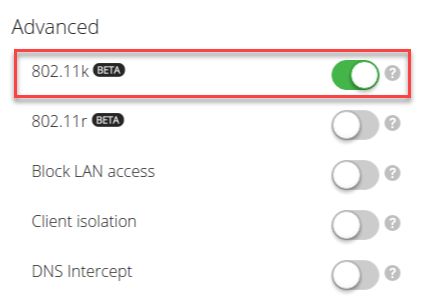Legacy Open Mesh : Client Device Roaming
This article describes the client device roaming features available for access points running firmware builds 6.5.0 or newer.
Environment
- Open Mesh Access Points
Description
Open Mesh access points implement multiple features and functionalities to ensure connected clients roam seamlessly from one access point to the next. Some of these are configurable to ensure the best performance for your network.
Enabling 802.11k
802.11k is an IEEE standard that provides client devices with a list of neighboring access points and their channels to select from prior to roaming, which expedites roaming operations.
To enable 802.11k, navigate to the SSID configuration pane and toggle it on.
[Configure > SSID X > Advanced > 802.11k (enable)]
Figure 1: Enabling 802.11k
Configuring Minimum Data Rates
Setting minimum data rates can improve the performance and roaming of client devices and overall WiFi network performance by disabling legacy data rates and reducing overhead. Both the 2.4GHz and 5GHz radios on access points have minimum data rate configurations.
To configure minimum data rates, navigate to [Configure > Radio > Minimum Data Rates], and use the respective dropdowns for 2.4 GHz and 5GHz to configure their minimum data rates, as shown in Figure 2. The following options are available:
Figure 2: Minimum Data Rates
2.4GHz
- Enable lower legacy data rates
- Disable lower legacy data rates
- Disable 802.11b rates only
Legacy 2.4GHz data rates are 1, 2, 5.5, 6, 9, 11, 12, and 18 Mbps. 802.11b data rates are 1, 2, 5.5, and 11 Mbps.
5GHz
- Enable lower legacy data rates
- Disable lower legacy data rates
Legacy 5GHz data rates are 6, 9, 12, and 18 Mbps. 802.11b is unsupported on 5GHz networks.





